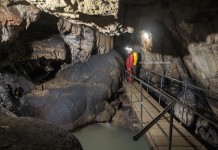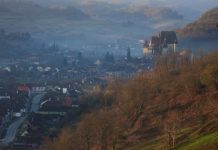The Apuseni Natural Park houses approximately 1500 caves, many of which entering the national or even international top rankings – the park’s area contains 80% of the total karstic rocks in Bihor-Vladeasa Mountains.
The region’s geological complexity created the necessary premises for the formation of the wonderful karstic relief which contains caves and dens with peculiar morphogenetic features. The degree of karst generated by the conditions of the environment in the Apuseni Mountains is 1.92/km.

Caving sightseeing objectives in Apuseni Natural Park – you can visit four show caves for tourists, three of which having electrical system.
For specialized tour guide – contact info
1. Scarisoara Cave – is the first caving sightseeing objective which in 1933 gained the status of speleological reservation. This is due to the well-known scientist, Emil Racovita, the one who laid the foundations of bio-speleology.
He was the first one to study the cave for the first time which houses the biggest underground glacier in Romania of 75000 mc and is 3000 years old. Unique in south-eastern European and easily accessible, you can reach this objective by car or bike, from Garda locality (Alba County).


2. Bear Cave – this caving objective is probably the most modernized touristic objective in Romania.
Discovered by accident in 1975, this cave has a rich diversity in terms of rock formations. Another forte of this cave is the paleontological deposit it possesses.
A part of the bones of the Ursus Spealeus found in the Bone Gallery we can be admired along the path. The access to this cave is readily accessible – by car in the Chiscau locality (Bihor County), where the cave is situated.
3. Poarta lui Ionele Cave – it has been recently arranged; the cave with an impressive portal of 15 m high doesn’t abound in rock formations. We recommend visiting this cave due to its geographical position (near the access road to Scarisoara Cave).
You will most definitely be impressed by the slopes of the Ordancusei Gorge where the cave is situated.

4. Vartop Cave – this cave is usually mistaken for Vartop Glacier; this cave does not house a permanent glacier. In the summertime one could observe its absence in the entrance room
This cave can be visited only by getting in touch with a local guide from Casa de Piatra village; this cave has no electrical system. The guide will provide you with torches and protective helmets.
This cave is rudimentary arranged, the route is barely marked; this experience is close to what speleology truly means. You will get here from Garda locality, ascending the road parallel to Garda Seaca Valley until you reach Casa de Piatra village.
This cave’s excellence stems from the three foot prints of the prehistoric man (Neanderthal) – one is found in the “Emil Racovita” Institute of Speleology in Cluj-Napoca, and the other two were stolen.
Access procedure in caves of Apuseni Natural Park – In Romania, according to the cave legislations, the caves are classified, each having a degree of importance (A being the best).

Check the classification that is found here) and see what degree of importance has the cave that you want to visit. After that:
1. Submit a request to the Speleological Patrimony Committee, click here to download the request and sending it here: patrimoniuspeo@yahoo.com
2. Submit a request to “Salvaspeo” Rescue Team Service, Bihor County (attaching the aforementioned notices) and send it here: salvamontbihor@yahoo.com
3. Submit a request to Apuseni Natural Park Administration (you have to attach the Speleological Patrimony Committee’s notice + Rescue notice) and send it here: office@parcapuseni.ro
Sometimes if the cave you want to visit is not in the A or B class, you will only need to provide the notices mentioned at 2. and 3. Better contact the Park administration before sending the requests.
In Apuseni Natural Park, for all the visitors who aren’t affiliated to the Romanian Speleology Federation, a tax of 10 RON/person/cave is needed, fee which is paid to the park’s administration.
If the cave you want to visit it’s not on the downloaded list it means that it’s not classified and you still have to ask for the three requests.

The most important caves in the Apuseni Natural Park (which can either be visited or not due to their degree of importance)
We recommend to visit the caves having a guide or with a speleology club due to the difficulties of the caves around.
1. V5 pothole – the deepest cave in Romania, with a level difference of -653. The pothole belongs to one of the most underground hydrological networks, the Varasoaia network. In order to visit this cave, physical fitness is recommended, vast experience in speleology and knowing how to descend the verticals on a rope.
At the moment the cave is being explored and charted. In the drought season people bivouac in order to charter the system. The underground hollow is of about 18 km. What’s more, the Paul Matos chamber stands out with a 12000000 mc and a length of 415 m.

2. Piatra Altarului Cave – degree of protection: class A. it is considered one of the most beautiful caves in Romania, and its access is quite restrictive. According to the management plan, the maximum number of people allowed in this cave/year is 13 (preferably researchers). The exceptional scenery, bounty of rock formations and the limestone speleothems make Palace chamber and Paradise chamber to be the most beautifully shaped caves in Europe.
3. Valea Rea Cave (Bad Valley cave)- the most complex cave in Romania due to its caving minerals. Over 35 identified minerals put this cave on the list of 10 best caves of this sort in the world. It contains the biggest underground waterfall which is perfectly vertical in Romania (Ventilatorului Waterfall): 82 m and a diameter of 10 m. It is the biggest cave which is wholly formed from Dolomite and has 16 km long.

4. Cetatile Ponorului Cave – details
5. Humpleu Cave – class A and B. The main features of the cave are: huge dimensions (length and width), the length of the underground river( with rich bounty and variety of speleothems which embellish the chambers and galleries), the chambers’ volume

Up to present only 22 chambers have been discovered, and three of them are the largest in Romania.
1. Giants’ Chamber: 750m/111m/35, volume of 2.800.000mc, second in size in Europe;
2. Dance Chamber: 304m/77m/55m, volume of 406.000mc;
3. Dan Coman Chamber: 242m/73m/23m, volume of 410.000 mc.
The Humpley system sums up 42 charted km.

6. Micula Cave – class A cave, it has been declared a scientific reservation. It was discovered in 1978 in Craiasa Valley near the village of Chiscau. Micula Cave is a beautiful cavern, rich in shape, housing a variety of rock formations.
Large spaces alternate with galleries and narrow fissures, lakes, active water flow and waterfalls, domes, stalactites, stalagmites, pillars and columns, cave pearls which bring a certain charm to the cave. Of great value is the paleontological vestige, namely the bear cave bones (Ursus spelaeus), its skeleton but without its skull.
7. Zgurasti Cave – situated on the left versant of the Garda Seaca Valley neighbouring Poarta lui Ionele Cave (tourist cave), we suggest that you visit this cave at the entrance, even if you are a layman, due to this cave’s impressive dimension: entrance chamber 65m/40m/ 35m high, where you can see an underground lake of about 25 m.
It houses the largest underground lake in Romania (65 m long, 20 m wide, 12 m deep). Has the largest permanent water accumulation in the Romanian caves (the lakes: Mare, Reck, Ascuns, Bailor de Namol Chamber, Velenta, Lung, Styx which sum up to a water volume of 25 000 mc)
8. Bortig pothole – degree of importance – class C – it houses the second largest underground glacier in Romania (30000 mc), after Scarisoara Cave. It has a depth of 54 m and its ground can be cover with the aid of a rope.
The first vertical of 38 m connects us to the superior part of the glacier. From there is a descending vertical of 15 m on the glacier. We recommend visiting this cave only if you are part of an experienced team. Moreover, we suggest you don’t use ice crampons, since it could deteriorate the glacier.

9. Coiba Mare Cave – degree of importance – class B. This cave has the largest entrance in Romania (54×45 m = 2430 m2). You should wear a neoprene suit in case you visit the cave since it has an underground river, lakes, water flows and waterfalls (you need expertise in covering those verticals). The cave’s last lake where the speleologists stopped charting is called Death Lake and it remains an insurmountable obstacle even for divers.

10. Focul Viu Glacier – degree of importance – class A. Although this is a rather small cave – 165 m, its importance stems from the fact that it houses the third largest underground glacier in Romania, of about 25000 mc. The superior entrance (shaped like a pothole) allows direct penetration of sun light, creating wonderful optical phenomena which inspired the locals in naming the cave. Behind the ice deposit, there is a crevice which leads us to the inferior level of the cavern.

11. Coliboaia Cave – on September 20th, 2009, owing to the low level of the water flow surpassed only by Gabor Halasi, a team of Romanian speleologists were about to discover one of the most important speleological-archeological sites in Romania – the cavern paintings of Coliboaia Cave. Further studies on the prehistoric cavern paintings carried out by Romanian and foreign scientists have shown that the age of the paintings is approximately 30000.
The representations are: the head of a cave bear (25 cm), a feline or a horse (89 cm), a horse (45 cm), a head of a rhino (20 cm) and they date from the same time like the well-known Chauvet Cave in France. This is proof for the existence of the peoples in the romanian territory.
Other caves of great importance which need to be mentioned are: Barsa Cave, Zapodie- Neagra Cave System, Portile Bihorului Cave, Damini Cave, Pojarul Politei Cave, Onceasa Cave, Fagului Cave and many others.

Pentru versiunea in limba romana

































